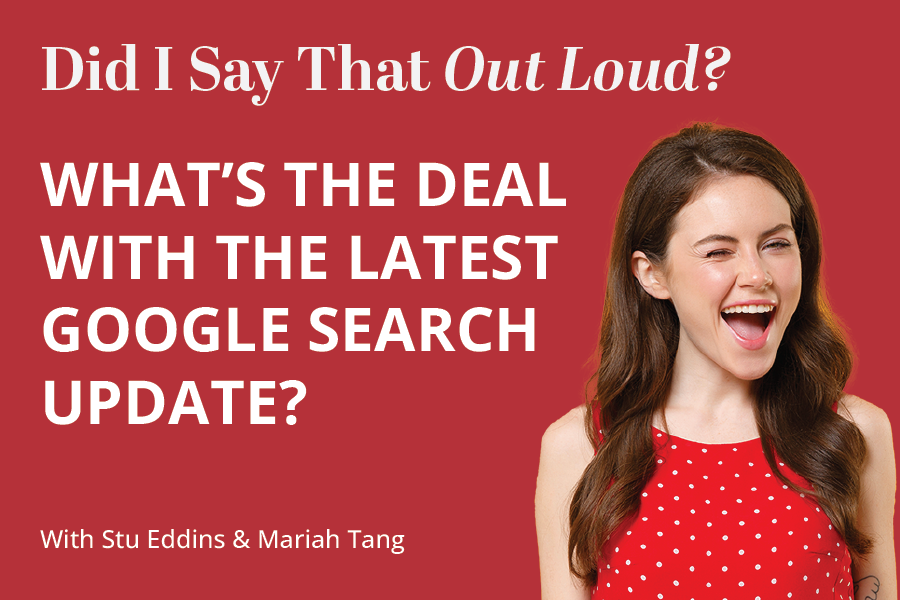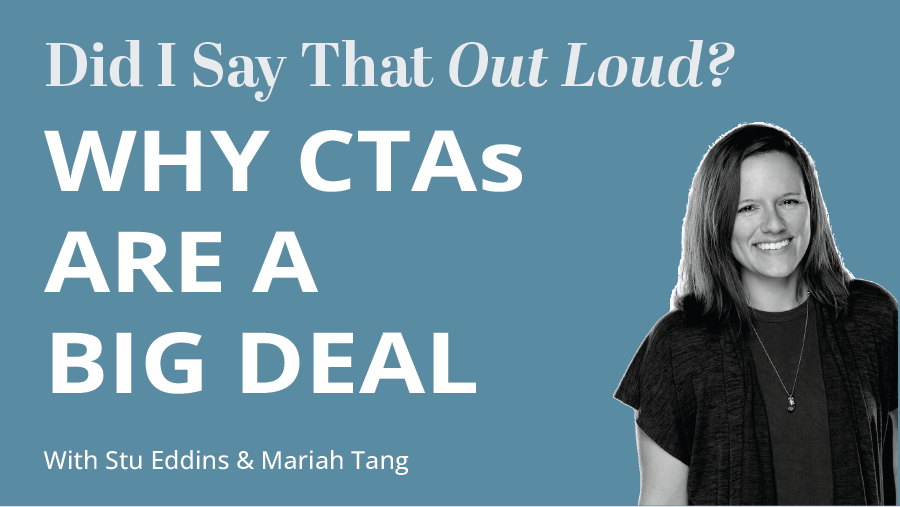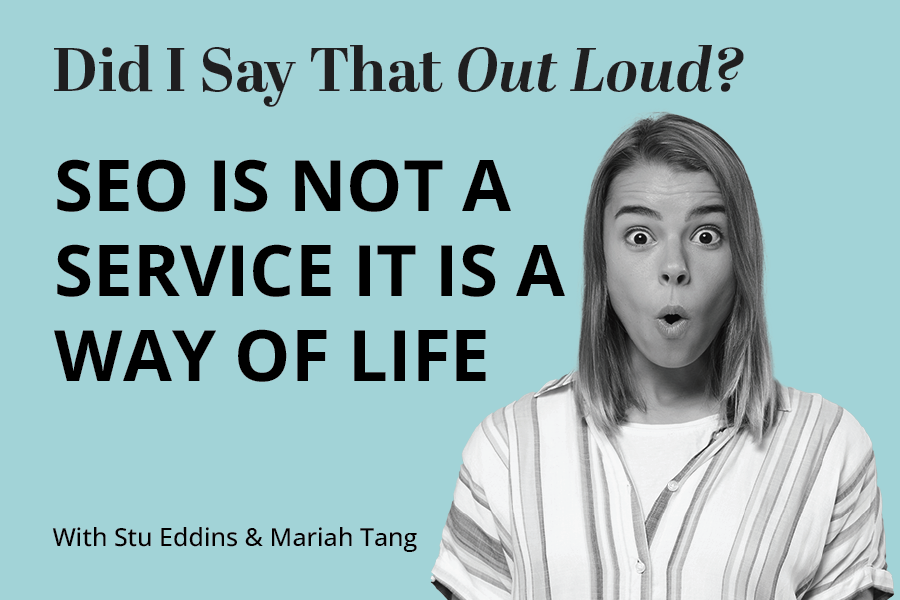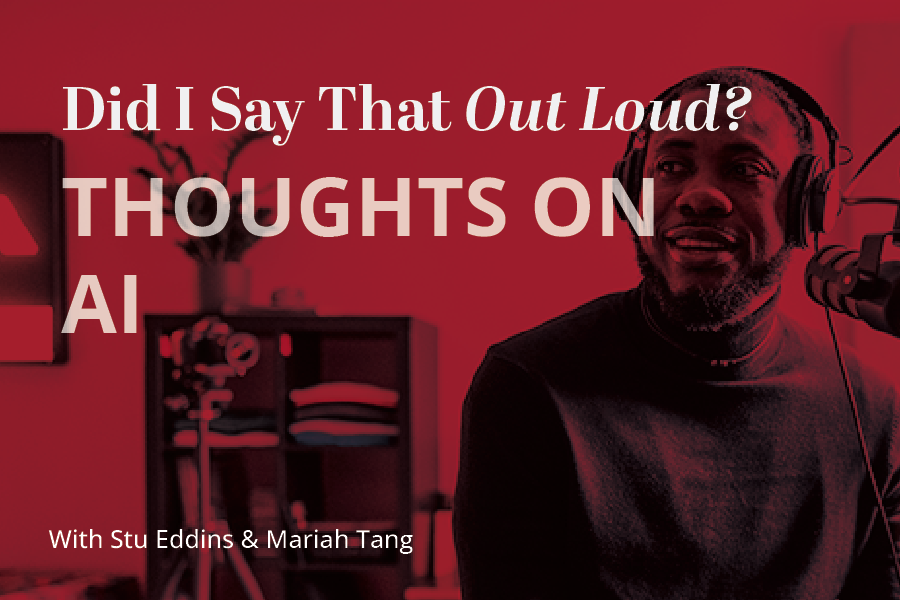
May 29th, 2024
Episode 1
Stu Eddins and Mariah Tang discuss the importance of search intent and authentic (not solely AI written) content in search ranking.
Listen to Episode
Transcript
Stu Eddins: The whole trend in SEO has always been how can I get Google’s attention? And how can I get Google to like me more?
Mariah Tang: Did I say that out loud? Welcome to did I say that out loud a podcast or Stu Eddins and Mariah Tang reflect on agency life and answer questions from our higher ed and healthcare clients about the latest in digital marketing, content and SEO.
Stu Eddins: Hi, welcome to the podcast. This is Stamats podcast, we’ve given it the name did i I say that out loud. Other than kind of a fun title. Our purpose here is to kind of capture some conversations and discussions we have internally about the things that impact digital marketing, digital websites, and, and pretty much anything else that falls within our daily chores and tasks and things we do for our clients. So yeah, did I say that out loud? That’s really a question I asked myself a lot. We do try to question what Google does, what Bing does, and so on, trying to find the best path forward. So loosely structured, but the premise of the whole thing is really kind of capturing a discussion. We’ve picked a topic, of course, we have some things that we want to talk about. But nothing more scripted than that. So today, we’re talking about what’s the deal with the latest Google content update? Well, actually, algorithm update. On March 5 of 2024, Google released a really, really big update, and how they rank pages in search. There’s a lot of implications that go along with it. And there’s a few that we kind of wanted to talk about a little bit. Probably one of the biggest changes was Google has had this assessment out there for a while called helpful content. It wants to find content that answers the questions that people put into search, the most helpful answer is its job. As much as we’d like to think that Google works with us, and we pay Google to do stuff. That’s our side of it. Google’s client is the person doing the search. It’s not the person really doing ads. It’s not the person doing SEO, Google lives to serve the person party putting a search query into their search, search engine. That’s the big deal to anything they put into that that search bar is a question. And helpful content is assessed on its ability to answer questions. That’s really what it comes down to
Mariah Tang: Like music to my ears. Yeah, we’ve been saying for years. Yeah, very validating.
Stu Eddins: Well, but the whole trend in SEO has always been how can we get Google’s attention? And how can I get Google to like me more? Yeah. Yeah. In, in a world that was focused on keywords and search terms and such. Yeah, Google at one point was something that that matched, okay, your page has this content. And the words match what somebody put in their search query, therefore, we’re going to, we’re going to serve your link to that person. Now, where it fit in ranking. In the order, it was served to the person. Yeah, that had a lot to do with your content and its quality. But Google stopped being a search engine based on on lexical search, it no longer really just matches words. It matches intent and content, it matches all sorts of things. Because it’s actually understanding the content of the page in front of it. When it looks like something you’ve written, right, it’s reading it. And it knows what people search for. And it tries to match these two things up, by intent by the quality of the answer you’re providing.
Mariah Tang: When Google started doing the purple highlight to answer when you type in a question, when essentially to a page, Google Now highlights the answer to that question on the page. First, I was scraped out by this and now I think it’s awesome. Yeah, it’s, it’s so validating, I keep coming back to that word, because for so long and content, we didn’t really have a way to say yes, this is working. No, this isn’t working. Unless it was oh, look, you’re number one on Google, you got this featured snippet, whatever. Now we have direct from Google user generated information, saying this is a great answer to this question. And it serves it up. It’s really awesome.
Stu Eddins: Yeah, in the thing that the thing that I think is helpful is Google is looking for helpful content, among many other things. Of course, there, there’s authoritativeness there, there’s a lot of things but helpful content is a good thing to talk about right now. And they do give you clues as to what to look for. There’s a link will share in the comments or the descriptive paragraph that accompanies the podcast that goes out to a page that Google has a series of questions you can use as a self assessment for what is considered helpful content right off the top. The easiest way to sum it up, and Google has been saying this for several years, but they may have put a finer point on it now. Your content should be written for people and not for search engines. That’s really kind of an important message, not the only message. But an important takeaway from this. What Google wants to surface for somebody who types of question into their search engine is a good well researched answer, something that provides a unique point of view. Something that really is a length that they would say, Yeah, you know what we recommend this thing?
Theory, not a fact. Yeah, well, and while you’re free to cite other people’s work, and whether it’s online or not, that’s good, because it substantiates what you put on the page, you really shouldn’t be regurgitating what you read elsewhere. That’s originality. There’s there’s many things that Google looks at. But think of that implication. That means Google is reading your content and can make the judgment about whether you’ve copied what somebody else said. And just rewarded it or not. Yeah, yeah.
Mariah Tang: So thinking about that big bold statements do what does this mean for AI assisted content and under the lens of Google has its own generate, you know, Jedi, and all of those things.
Stu Eddins: Yeah, the thing that I, I have an opinion on, let’s be very clear, this is an opinion. The other part about this March update was a reduction in spam content in search results. Now, Google has always been anti spam, they want to deliver clean results to their to their customers, we can understand that. But one part of spam, just one part of Spam is AI. Now, because they have their own AI tools out there. And frankly, Google’s been using AI since far longer than it’s been in the headlines. I mean, I do a lot of Google Ads work. They’ve been using AI and Google ads, since about 2007. That’s what quality score is, is is is an AI powered tool. So this has been around for a while. It’s just now come up into the zeitgeist is just just what people are aware of at the moment. But Google looks at things in perhaps a gradation. And this is my opinion, they look at original content that appears to have come from somebody who has written on the topic before. Another important thing. They know that this byline perhaps, is linked to other content on similar topic, authority. That’s the authority part of the Eat equation that they have. We’ll link to that too, if necessary. But Google does look at that part of the equation saying, okay, this person writes often on this topic, they’re considered an authority because people link to it, people stay on the content, they don’t bounce off of it, they read it, they scroll it, they do all this stuff. All this stuff goes into it. But then there’s AI Assisted writing. And that can be where, okay, we’ve gone out and gotten and used an AI tool, to not develop the content, but perhaps develop the outline. And then we address the points by that because it’s a nebulous topic. And we could use some help in organizing how we put the put the information we want to relate into a meaningful article to get it published. There’s other ways where AI assisted content can come in where perhaps you’ve used AI to come up with your citations. Because right now, for the most part, what’s happening on the web with AI, is large language model. It knows the stuff that’s already been written and can rearrange it into hopeful sentences and paragraphs.
Mariah Tang: It doesn’t really create original, no matter how wrong or how right, it is exactly to see is that a thing has been done, and it puts the thing in a new way. Exactly.
Stu Eddins: And that’s the next step, which is AI generated content. ages ago, I was doing SEO work for a website, back in the wild west days of websites that by said the year that would date me too much. But the process we use was at the time and authentic process to improve your search ranking. It was called link farming. We would take an article we would write it we would put it into a program was called a spinner, which would rearrange the the thoughts in the paragraphs in such a way that it looked like original content over and over and over again. And then take all that content and plant it across dozens of websites, all pointing back to my website, backlink building Blackhat is what that is. I know, I hated it too, because quite frankly, the content sucked. The spun content really was not that good. But at the point Google didn’t care or if they did they let on today, and we’ll come forward the better part of 20 years. Google knows the content. It’s no longer about matching a link to your website and saying it’s good enough. All of this matters. So when you use AI to generate content and plop it on your website, Google can pretty much detect it because it has this this copy of the web, if you will, in its possession. And it can look at the content and assess its quality, its origin, all sorts of stuff. So the spam update to bring this all the way back to the beginning of the statement, the spam, part of the update that happened in March, also has to do with hat also has to do with AI generated or AI assisted content. My personal opinion, I don’t think Google is going to crack down too much on AI usage as an assist, if they themselves are pushing forward with AI tools. But I think that that also implies that there’s some nuanced understanding on their part about how much and how you use AI.
Mariah Tang: Yeah. I’m glad that you brought up the backlinks thing. That’s one of the questions we get most often from our groups. And we always come back around to is your content helpful? Is it useful? Is it backlink worthy, and that’s what that’s what you’re talking about has to be worth that mention worth that person’s time to put your link on their site? You know, if you’re a good resource, if you’re a good Knowledge Hub, then that’s what that’s what makes you backlink worthy.
Stu Eddins: Yeah. And that’s actually an important way to put it the way you’ve said, backlink worthy, you may not have the backlinks yet, but Google looks at this in can assess to some degree saying hey, you know what, somebody could link to this, they will be useful to somebody linked to this. So yet again, a another non keyword driven, quality signal built into the system. So yeah, I think there’s a lot to come from that. Really what it comes down to, though, is this last update, the two headlines that we’re talking about the most internally, is the spam update we’ve just finished discussing, that also overlaps into the current AI discussion. Plus the fact that helpful content is now rolled into the core algorithm instead of the standalone isolated thing that says, hey, you could do better? Well, now we haven’t sent them. It’s part of the ranking. I guess, if I were to sum it up, I think one way to put it is the March update, among many other things encourages, as stated content written for people that is very helpful in answering questions, and is not closely associated other content that already exists. And really, that’s the big takeaway, right? Stuff meaningful to the people you want to talk to? And you have an answer for. Think of it that way.
Mariah Tang: You hit the nail on the head.
Stu Eddins: Well, one last thing on AI. AI is built on a language model presently, I think it was like 2001 2002 to 2021 freshness date, if you will. If you ask AI to answer a question, it’s only going to answer that question. If it’s possible by constructing sentences and paragraphs based on content and knowledge from 2021. Before. It’s not going to be very current. It also doesn’t do math. So another topic me either. Yeah, it’s it’s, it says one plus one equals two because it read it somewhere, not because it does the math. Yeah. But anyway, that’ll be another topic some of the day. Stories. Yeah, tell me stories. And that’s just not blog content, right? You have to be able to do that. Also with your, well, I consider organic content. If you’re if you’re a higher in higher education, that is the description of a program page. If you’re in healthcare, it’s going to be the description of your orthopedic knee replacements. Do something unique? You’re answering the same question everybody is, but say why? Perhaps you’re different per se, address something. Instead of simply saying we do we do knee replacements, and you’re back to work in three days. Add in information about what life is like afterward? Yeah, with the recovery, add more apt to answer the question asked, and then go on a little deeper, ask the neck and answer the next few questions that would come up.
Mariah Tang: Every page has a story, give him something to think about before, during and after given the next action step. keep that conversation going in.
Stu Eddins: That’s a good step toward being helpful. So but if you have any comments, of course, don’t hesitate to reach out we’ll answer the generated content. Yeah. We love that. But yeah, go ahead, ask ask us any questions you have on the topic or better yet, if you have an opinion, share that to the best part about learning is hearing everybody else’s thoughts on the subject. All right. Thank you. See you next time.
Thanks for listening to Did I Say That Out Loud? with Stu Eddins and Mariah Tang. Check out the show notes for more information about today’s episode. And if you have any questions, concerns or comments, hit us up anytime at stamats.com.
Let’s talk
You have questions, we have answers. Let’s talk about your upcoming project. Stamats addresses the challenges your team is facing. We will customize a solution that is guaranteed to impress.


